

Table of Contents
ToggleIntroduction: Materials for Kitchen Cabinets
The kitchen is the heart of every home, where delicious meals are prepared and memories are created. When it comes to kitchen cabinets, the choice of materials plays a pivotal role in not only the aesthetics but also the functionality and longevity of your culinary haven. In this extensive guide, we will delve into the world of kitchen cabinet materials to help you discover the best choices for your kitchen. From classic hardwoods to modern engineered options, we’ll explore the pros and cons, design possibilities, and maintenance requirements to ensure you make an informed decision with Mettas Lifestyle.
The Importance of Choosing the Right Cabinet Material
Your kitchen cabinets are not just functional; they are a significant design element that can set the tone for your kitchen’s overall aesthetic. The choice of materials impacts the appearance, durability, and maintenance of your kitchen cabinets. Here are a few key reasons why selecting the right materials for kitchen cabinets is essential:
Aesthetics: The material you choose will define the look of your kitchen. Whether you prefer a classic, rustic, contemporary, or minimalist style, the cabinet material sets the stage for your kitchen’s design.
Durability: Kitchens are high-traffic areas and subject to wear and tear. The cabinet material should be able to withstand the rigors of daily use, including exposure to heat, moisture, and spills.
Maintenance: Different materials have varying maintenance requirements. Choosing the right material ensures that you can keep your cabinets looking pristine with minimal effort.
Budget: The cost of materials can vary significantly. Selecting the right material that fits your budget is crucial to a successful kitchen renovation.
Environmental Impact: Some materials are more sustainable and environmentally friendly than others. Your choice can have an impact on the environment.
Now, let’s explore the best materials for kitchen cabinets, their unique characteristics, and the advantages they offer.
1. Hardwood
Hardwood is a timeless and popular choice for kitchen cabinets. It’s renowned for its natural beauty, durability, and versatility. Some of the hardwood options include oak, cherry, maple, and hickory.
Pros:
- Aesthetic Appeal: Hardwood kitchen cabinets exude warmth and elegance. They offer a classic and timeless look that complements various kitchen styles.
- Durability: Hardwood is exceptionally durable and can withstand years of use. It resists scratches and dents effectively.
- Variety: With different hardwood species available, you can find a wood that matches your preferred color and grain pattern.
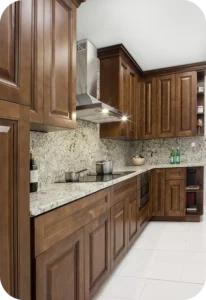
Cons:
- Cost: Hardwood cabinets can be on the expensive side, but their longevity justifies the investment.
- Maintenance: They may require occasional refinishing to maintain their appearance.
2. Plywood
Plywood is a versatile material made from layers of wood veneers. It’s known for its strength and is often used as the base material for kitchen cabinets.
Pros:
- Strength: Plywood kitchen cabinets are incredibly sturdy and less susceptible to warping and cracking compared to solid wood.
- Cost-effective: It offers a balance between quality and cost, making it an attractive option for many homeowners.
- Smooth Finish: Plywood provides a smooth and consistent surface for finishes and paints.

Cons:
- Aesthetics: While plywood is strong and reliable, it may not have the same natural beauty as hardwood.
- Veneer Quality: The quality of the plywood can vary, so it’s essential to choose a reputable brand.
3. Medium-Density Fiberboard (MDF)
MDF is an engineered wood product made from wood fibers, wax, and resin. It’s an excellent choice for cabinet doors and panels.
Pros:
- Smooth Finish: MDF has a smooth, uniform surface that’s perfect for painting or applying veneers.
- Versatility: It can be shaped into various styles and profiles, offering endless design possibilities.
- Cost-effective: MDF is an economical option that provides a high-quality finish.
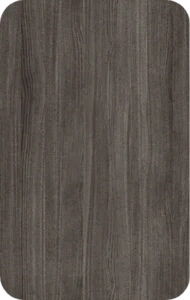
Cons:
- Moisture Sensitivity: MDF is not suitable for areas prone to moisture, as it can swell and deteriorate when exposed to water.
- Durability: While it’s durable for most kitchen cabinet uses, it may not be as robust as hardwood or plywood.
4. Particleboard
Particleboard is another engineered wood product made from wood chips, resin, and adhesive. It’s typically used for cabinet sides, shelves, and cabinet boxes.
Pros:
- Cost-effective: Particleboard is one of the most budget-friendly options for cabinet construction.
- Smooth Finish: It provides a smooth surface that’s suitable for laminate or veneer finishes.
- Stability: It maintains its shape and is resistant to warping.
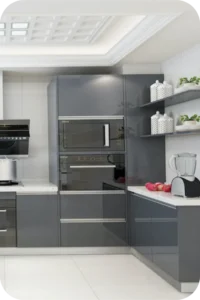
Cons:
- Moisture Vulnerability: Like MDF, particleboard is susceptible to moisture damage and should not be used in areas prone to water exposure.
- Limited Strength: It may not be as strong as plywood or hardwood, so it’s essential to use it for appropriate cabinet components.
5. Stainless Steel
Stainless steel kitchen cabinets are a modern and sleek choice for contemporary kitchens. They are known for their durability and resistance to corrosion.
Pros:
- Durability: Stainless steel cabinets are incredibly durable and resistant to rust, making them suitable for high-moisture environments.
- Hygienic: They are easy to clean and maintain, and they are often used in commercial kitchens for their sanitary qualities.
- Modern Aesthetics: Stainless steel cabinets offer a minimalist and industrial look that’s perfect for modern kitchen inventions.
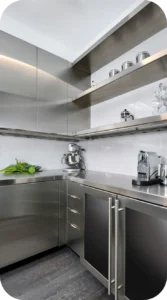
Cons:
- Cost: Stainless steel cabinets can be expensive, and the price may vary depending on the gauge and finish.
- Appearance: While they have a unique and modern appeal, they may not be the right choice for traditional or rustic kitchens.
6. Thermofoil
Thermofoil cabinets are constructed from MDF or particleboard and coated with a heat-sealed vinyl layer. They are known for their affordability and easy maintenance.
Pros:
- Affordability: Thermofoil cabinets are one of the most budget-friendly options available.
- Variety of Styles: They come in a wide range of colors and styles, making it easy to find a look that suits your kitchen.
- Low Maintenance: Thermofoil is easy to clean and doesn’t require refinishing.
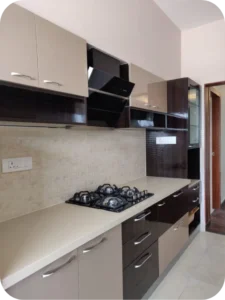
Cons:
- Durability: While they are moisture-resistant, they may not be as durable as other materials like hardwood or stainless steel.
- Limited Repairability: Thermofoil can be more challenging to repair if it becomes damaged.
7. Laminate
Laminate cabinets are made from layers of paper and resin that are bonded to a composite base. They are a cost-effective and low-maintenance option.
Pros:
- Affordability: Laminate cabinets are budget-friendly and provide excellent value for money.
- Wide Variety: They come in an extensive range of colors and patterns, allowing for creative and customized designs.
- Easy Maintenance: Laminate is easy to clean and resistant to stains.
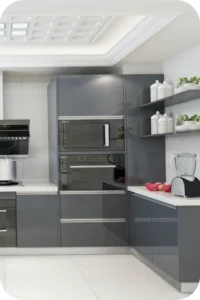
Cons:
- Moisture Sensitivity: Laminate is vulnerable to water damage and may not be suitable for areas near sinks or dishwashers.
- Limited Repairability: It can be challenging to repair chipped or damaged laminate surfaces.
8. Glass
Glass-front cabinets are an elegant and sophisticated choice that allows you to showcase your dishes and glassware.
Pros:
- Aesthetic Appeal: Glass cabinets offer a unique and stylish way to display your kitchen items.
- Light and airy: They make the kitchen feel more open and spacious.
- Variety: You can choose from various types of glass, including clear, frosted, or textured.

Cons:
- Maintenance: Glass requires regular cleaning to maintain its transparency and appeal.
- Organization: Since the contents of the cabinets are visible, they need to be well-organized and aesthetically pleasing.
9. Bamboo
Bamboo is a sustainable and eco-friendly option for kitchen cabinets. It’s a rapidly renewable resource that offers a unique and natural look.
Pros:
- Sustainability: Bamboo is a highly sustainable material, as it grows rapidly and doesn’t require the same level of chemicals and maintenance as traditional hardwoods.
- Durability: Bamboo is strong and durable, making it suitable for kitchen cabinets.
- Unique Appearance: Its natural grain and color variations add a distinct character to your kitchen.
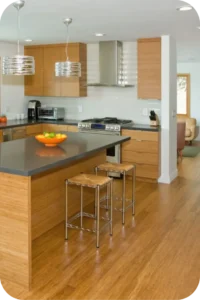
Cons:
- Cost: Bamboo cabinets can be on the expensive side due to their eco-friendly and sustainable attributes.
- Availability: Finding bamboo cabinets may be more challenging compared to other materials.
10. Melamine
Melamine cabinets are made from particleboard or MDF covered with a paper or resin overlay that can mimic various materials, such as wood or stone.
Pros:
- Affordability: Melamine kitchen cabinets are a cost-effective option that can replicate the look of more expensive materials.
- Variety: They come in various finishes and styles, allowing you to achieve the desired aesthetic.
- Low Maintenance: Melamine is easy to clean and doesn’t require refinishing.

Cons:
- Moisture Sensitivity: Like other engineered wood products, melamine can be vulnerable to water damage.
- Durability: They may not be as robust as hardwood or stainless steel, so they are best suited for areas that don’t experience heavy wear and tear.
11. Acrylic
Acrylic kitchen cabinets are made from high-gloss acrylic panels applied to a substrate. They offer a sleek and modern look for contemporary kitchens.
Pros:
- Aesthetic Appeal: Acrylic cabinets have a high-gloss, reflective surface that adds a contemporary and luxurious feel to the kitchen.
- Durability: They are resistant to scratches and fading, maintaining their appearance over time.
- Variety: They come in various colors, making it easy to match your kitchen’s color scheme.

Cons:
- Cost: Acrylic cabinets are on the more expensive side due to their glossy and modern appearance.
- Fingerprints: The glossy surface can show fingerprints and smudges, requiring frequent cleaning.
12. Concrete
Concrete kitchen cabinets provide a unique and industrial look for modern kitchens. They are typically used in outdoor kitchens, but they can also be used indoors.
Pros:
- Unique Aesthetics: Concrete cabinets offer an industrial and modern appearance that stands out.
- Durability: They are incredibly strong and resistant to heat, making them ideal for outdoor use.
- Customization: Concrete can be customized with various finishes and colors.

Cons:
- Cost: Concrete cabinets can be expensive due to the specialized construction and customization involved.
- Weight: They are heavy, so the kitchen structure must support the weight of the concrete cabinets.
Choosing the Right Material for Your Kitchen Cabinets
Choosing the right material for your kitchen cabinets is a crucial decision that should align with your preferences, budget, and lifestyle. Here are some considerations to help you make an informed choice:
Aesthetic Preference: Consider the style and look you want to achieve in your kitchen. Do you prefer a traditional, modern, or eclectic design?
Budget: Determine your budget for kitchen cabinet materials. Keep in mind that different materials come with varying price points.
Durability: Assess the level of wear and tear your kitchen cabinets will endure. For high-traffic kitchens, durability is a critical factor.
Maintenance: Consider how much time and effort you’re willing to invest in maintaining your cabinets. Some materials require more care than others.
Environmental Impact: If sustainability is important to you, explore eco-friendly options like bamboo or consider materials that are certified as environmentally responsible.
Climatic Conditions: Be mindful of your kitchen’s location and exposure to moisture. Some materials are better suited for humid environments.
Resale Value: If you plan to sell your home in the future, choose materials that are appealing to potential buyers and add value to your property.
Customization: Determine how much flexibility you want in terms of cabinet design and style.
To make the right choice, it’s often helpful to consult with a professional kitchen designer or contractor. They can provide insights based on your specific kitchen layout and needs.
Conclusion
The choice of kitchen cabinet materials significantly impacts the look, functionality, and longevity of your kitchen. Whether you prefer the timeless appeal of hardwood, the modern aesthetics of stainless steel, or budget-friendly options like laminate or MDF, there’s a material that suits your needs and style.
Before making your final decision, carefully assess your preferences, budget, and the conditions of your kitchen. By doing so, you’ll be well on your way to creating a kitchen that not only serves as the heart of your home but also reflects your style and values. So, start exploring the world of kitchen cabinet materials and bring your dream kitchen to life.
Related topics you must read: Benefits of Rolling Shutters in Modular Kitchen Cabinets
FAQs
The best material for kitchen cabinets depends on your specific needs and preferences. Hardwood, plywood, and stainless steel are often considered excellent choices for their durability and aesthetics. However, the “best” material will vary from one kitchen to another based on factors such as budget, design style, and expected wear and tear.
Particleboard and melamine are typically the most budget-friendly options for kitchen cabinets. These materials offer cost-effective solutions without compromising quality. They are excellent choices for those on a tight budget.
Laminate cabinets are durable and resistant to stains and scratches. They are a practical choice for those seeking both durability and affordability. However, they are sensitive to moisture, so it’s essential to avoid placing them in areas prone to water exposure.
Bamboo is often regarded as one of the most environmentally friendly kitchen cabinet materials. Bamboo is a rapidly renewable resource, making it a sustainable choice. Additionally, choosing cabinet materials with low levels of formaldehyde and other harmful chemicals can contribute to environmental friendliness.
Stainless steel cabinets are relatively low-maintenance. Regular cleaning with a mild detergent and a soft cloth is usually sufficient to maintain their appearance. Avoid using abrasive materials that could scratch the surface, and wipe away any water or liquid promptly to prevent water spots.
Yes, many kitchen cabinet materials, such as wood and MDF, can be painted or refinished to change their appearance. This allows you to update the look of your cabinets without the need for a complete replacement. However, materials like stainless steel, concrete, or glass may not be as easily refinished.
For high-humidity areas like bathrooms, it’s essential to choose materials that are resistant to moisture and humidity. Plywood and MDF with a waterproof finish are often recommended for bathroom cabinets. These materials can withstand the challenges posed by humidity without warping or deteriorating.
Glass-front cabinets can be used in various kitchen styles, but they are most commonly associated with traditional, cottage, or transitional designs. They allow for the display of dishes and glassware, adding a touch of elegance to the kitchen. However, they may not be the best choice for minimalist or modern kitchen designs.
Yes, combining different cabinet materials can create a unique and visually appealing kitchen. For instance, you can use hardwood for the base cabinets and glass or open shelving for the upper cabinets. This combination adds depth and visual interest to the kitchen.
Selecting the right kitchen cabinet material involves considering factors like your budget, preferred style, anticipated wear and tear, and maintenance requirements. It’s advisable to consult with a professional kitchen designer or contractor who can assess your specific needs and provide recommendations tailored to your kitchen’s layout and your personal preferences. They can help you make an informed decision based on your unique requirements.
Choosing the right kitchen cabinet material is a crucial step in creating a functional and visually appealing kitchen. By understanding the characteristics and considerations related to each material, you can make an informed choice that aligns with your needs and design preferences.

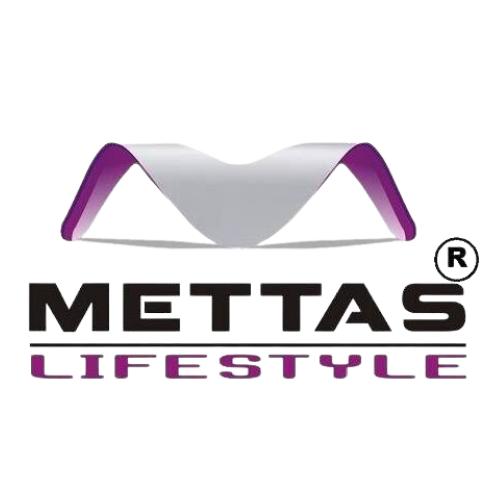
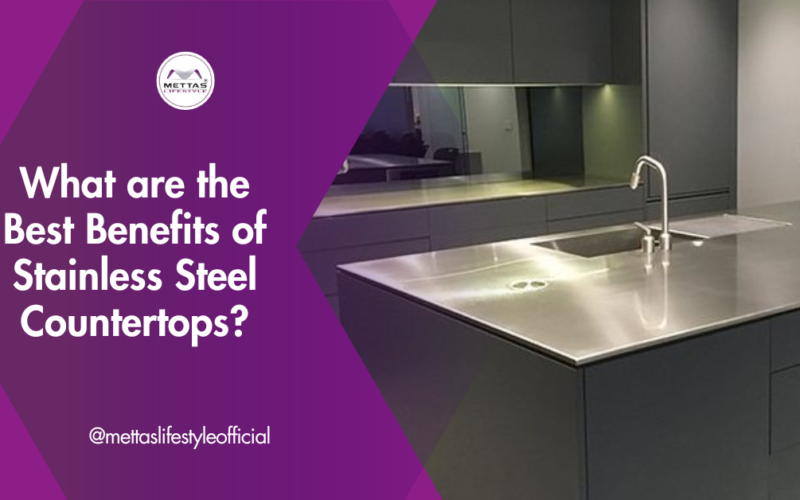


3 comments. Leave new
[…] topics you must read: Materials for Kitchen Cabinets: Discover the Best […]
[…] topics you must read: Optimal Materials for Kitchen Cabinets: Discover the Best […]
[…] Have questions about your next renovation project? We’ve got answers. Let’s do this together. […]